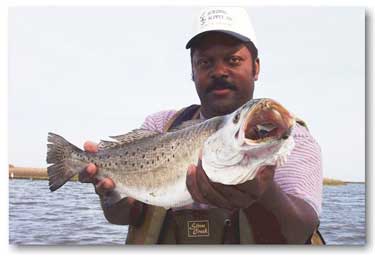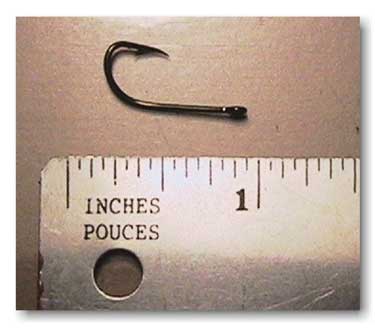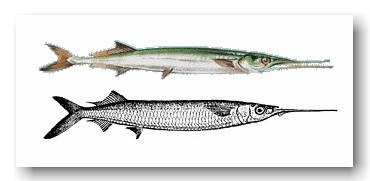Springtime Speckled Trout Fever
Springtime Speckled Trout Fever
By Jerry LaBella
Springtime speckled trout fishing fever is an addiction only the hardcore speck angler can relate to. It's the time of year that offers speckled trout anglers the opportunity to land a real wall-hanger.
Veteran anglers share their secrets to successfully catching one of these trophy-sized speckled trout.
It is a debilitating affliction; no angler is immune. The symptoms begin to show up during or about the final week of wintertime, when blooming vegetation begins acquiring their original colors and fragrances.
Over the winter haul, for many anglers, the illness is only heightened by the constant listening to the weather channel, looking at fishing maps, and perusing through the tackle box.
Yes! It's springtime and the speckled trout fishing fever is running rampant throughout the south. During this time of year, the illness will only escalate by the mere sighting of a speckled trout on the end of anyone's fishing line.
It's safe to say that only a select group of anglers have actually ever caught what's called a real "wall-hanger," "trophy trout," "line smoker," or whatever your terminology is for a speckled trout in the heavy-weight contender class.
Actually, trout between 4 - 5 lbs. are often referred loosely to the previously described; but, not to hurt anyone's feelings, those sizes are not "trophy trout" in the true sense.
The true trophy trout reaper understanding that the "where," "when," and "how" can either make or break you, depending on the degree to which you have appreciated each. Now it's true, however, that some anglers have accidentally caught a trophy sized speckled trout with limited understand of the aforesaid. Some have even placed in the state record book or won rodeos with their catch. All of such occurrences only adds more hype to the springtime speckled trout fishing fever.
But what size does a speckled trout have to be in order to be considered a "trophy speckled trout?"
The answer, no doubt, would totally depend on where and to whom you would pose that question.
Understandably, since this species occupies waters throughout a wide range of states, one would have to first consider the fishing pressure heaped upon it from both commercial and sport user groups. This, of course, varies drastically from state to state. Added to that consideration is the fact that only a small percentage of spawners live long enough to grow larger than four pounds. So, simply stated, what might be called a trophy trout in one place may be only mediocre elsewhere.
It's safe to say that a speckled trout 7 1bs. or more might be considered a trophy trout. That's applicable for most of Louisiana , since further west, near the Texas/Louisiana border, that size is significantly more common. This is true with some other places in the surrounding Gulf Coast states, which yield specks regularly over eight pounds.
Such places can contribute that type of success to their strict marine fish management and enforcement programs.
It's no secret, to the well-informed angler, that springtime is one of the foremost seasons for yielding trout in the trophy sized class. In fact, most authorities and professional guides agree that it is this time of year that the odds are at their greatest for that dreamed about speckled trout to become a reality.
Trophy sized speckled trout are distinctively different in appearance: black spots the size of pennies scattered along their sides, fist-sized, yellow mouths, and stomachs bloating from roe waiting to erupt. They more resemble a freak of nature because of their rarity.
Springtime offers ideal conditions for your chance to catch a trophy sized speckled trout. For example, marine biologist claim that when water temperatures reach around 68 degrees, speckled trout begin spawning. However, there are other influencing factors that come into play as well. Such as length of daylight and water salinity; and it all seems to come together during this time.
 Wall-hanger Speckled Trout: Tim Mulmore, a veteran speckled trout angler, shows off a giant springtime Louisiana speckled trout- with a mouth big enough for a man's fist to fit into.
Wall-hanger Speckled Trout: Tim Mulmore, a veteran speckled trout angler, shows off a giant springtime Louisiana speckled trout- with a mouth big enough for a man's fist to fit into.
Basically, big spawners are considered by experts to be loners, only coming together in numbers for a brief time for the purpose of propagating. They can be found in deeper, open waters of the near-shore Gulf– but not solely. And, as the spawn builds to a climax, they are in continuous search for food to rejuvenate their bodies from the toilsome activities.
Those in the know, know when to go! Most big speckled trout angler veterans agree that the trout spawn is triggered during the first full moon in May, when temperatures reach between 68 and 74 degrees.
Even though such factors as water temperature, salinity, length of daylight, and time of year all play a vital roll in bringing these big trout together, there are variations that can impede these components to some extent.
For example, the salinity factor can be influenced greatly both on the inside and outside waters if heavy spring showers and/or snow melting from the north persist to an unusual degree. Such conditions will influence whether the spawners choose that area or not. Never think that just because you have caught big trout in one location one year that they'll inevitably be there again.
The benefits of moving away from areas that are likely to be adversely affected should be obvious. Two highly susceptible places in Louisiana are those in and around the Atchafalaya River and the Mississippi River, two heavy fresh water generators..
Big trout during spring are often targeted along the coastal beaches and inside areas near the Gulf where various types of structure draw bait. They can even be caught at or near the two aforesaid rivers if a dry season occurs causing low river stages to linger.
The smart angler, nonetheless, will always have several optional areas to try and won't be pinned down to any one locality in the event it proves unfruitful.
Good conservation is another factor that should always be kept in mind when going after any fish in the spawning class; considering the fact that spawners represent future fish stocks, they should be handled as little as possible and released readily. I know some will sneer at such a suggestion, but these size trout are not good table fare because their flesh is oily and inferior to trout four pounds and under.
Those who are conservational minded regularly release spawners, documenting their catch with the use of a camera, fish scale, and tape measure. This way a reproduction of the fish can be a accurately made by a skilled taxidermist at a convenient time.
While it's true that every big trout seeker has his own secret bait and method for success, it is arguable that live bait is most likely to prove best in comparison to artificials. Don't take this to mean that big trout cannot be caught on certain lures at certain times, nonetheless. Of course this is generally true only after one has put much time and effort into it the techniques of the art of lure fishing.
Take Captain Poe of Cameron, Louisiana , for example. He's a professional big speckled trout guide who prefers fishing with the jointed Thunder Stick lure. This is a top-water lure, constructed in two pieces and jointed in the middle to mimic a injured swimming bait fish when retrieved through the water.
While this is his first choice when going after the big boys, his next best choice is a six-inch live croaker or mullet. His theory- like many big fish hunters- is that the bigger baits catch the big fish.
Captain Poe says anglers fishing the Cameron area may catch trout as big as eight pounds or so and, if they are really fortunate, might even land a speckled trout in the ten-pound class.
Some of Captain Poe's favorite big speckled trout fishing holes lie at the south end of Calcasieu Lake and the beach surf between Sabine Pass and the Mermantau River. He says that as soon as the school mullet show up, the big trout action begins; and, this stretch of coastal surf covers a lot of territory for the big trout searcher to capitalize on. Speckled trout from this zone commonly run between 6 and 7 ponds, and they favor this locality preferably because of the high salinity factor common to the region.
Hopedale, Louisiana, is another big-trout territory. Some popular places are the famous Black Tanks, Eight Pilings, and Battledore Reef. Here is where live shrimp on a Carolina rig seems to rule. However, the wellheads and oil rigs throughout that area produce big trout as well. Particularly at night, large speckled trout like congregating under the subdued lights of these structures in early spring.
But there are locals guides who will argue that Lake Pontchartrain, the states biggest lake, produces the biggest speckled trout. Validating this is the fact that two speckled trout state fish records were caught here.
Like most other predator fish, speckled trout feed on what's available in the water for that season. Abundant in the water during spring are silverside minnows (glass minnows), often overlooked by speckled trout anglers. These delicate minnows have transparent bodies with a thin silver stripe running horizontally along their sides. These minnows are very short-lived out of the water and even in most bait tanks. The best size to fish with are those of at least 3 inches. The big trick in fishing them is hooking them so that they don't readily die.
 The #6 Eagle Claw 089a is small enough to allow the silverside minnow to swim yet strong enough to penetrate the hard ridge area
of the speckled trout's mouth.
The #6 Eagle Claw 089a is small enough to allow the silverside minnow to swim yet strong enough to penetrate the hard ridge area
of the speckled trout's mouth.
The best method is to hook them under their lower jaw and pass the hook through the upper portion of their mouth, just ahead of their eyes. It's very essential to support the top portion of their head when doing this or the minnow's backbone will break, resulting in instant death. The placement of the hook, its size, and thickness are obviously crucial. The #6 Eagle Claw 089A hook or equivalent is ideal for the job– small and strong yet light enough for the bait to swim.
Line type is also important when fishing these baits. The objective is to allow the bait to freely swim . Ideal mono line size should not exceed 20 lbs. Braided line is best in the 6/20 class, but a fluorocarbon leader is recommended because of its invisibility.
Silver side minnows can be fished just like any other live bait for trout. But under lighted structures at night, freelined method works best when the trout are feeding on the surface. When fishing the bottom use a bottom drop leader rig or a Carolina Rig.
These hooks are small but very strong and penetrate virtually every time in the hard ridge part of the trout's mouth. As mentioned, these minnows are especially abundant in spring and can be caught at night by hanging a submersible fishing light in the water which will attract them. Then, a scoop net can be used to catch them as needed.
Out of all the big-trout baits that are used, two exceptional live baits are most often overlooked: the ballyhoo and the needlefish. These baits are often confused but are distinctly different when scrutinized.
One of the main differences is the mouth beaks. True, both fish may look the same in the water, but the needlefish has a long needle mouth protrusion on both its upper and lower jaw sections; while the ballyhoo's upper mouth section has a very short needle protrusion compared to its very longer lower counterpart.
Despite the fact that each of these species can grow a foot or more in length, make no mistake about it, speckled trout have an uncanny weakness to eat them. Due to their elongated size and the fact that trout generally hit a bait head first, it is essential to hook the bait in the mouth section ahead of their eyes and to let the trout run on a loose line before setting the hook. Consequently, a large hook is best, generally a thin gauge type in the 6/0-7/0 size, long shank.
 Big speckled trout have an uncanny weakness to eat these baits despite the fact they can grow to more than a foot in length.
Big speckled trout have an uncanny weakness to eat these baits despite the fact they can grow to more than a foot in length.
Every successful speckled trout angler knows that the key to fooling large, wary speckled trout lies in the presentation. So whether you're using live bait or lures, it must look real. Thus, avoid using heavy line, snap swivels, and steel leaders that can hinder the bait's performance.
Veteran angler and marina owner Blackie Campo of Shell Beach, Louisiana , is one who swears by live giant-sized cocahoe minnows or live croakers as the preferred big trout taker. He recommends trying them on a Carolina Rig or just freelining them if the current isn't too strong. His favorite hunting grounds are the mouth of the Mississippi Gulf Outlet canal and its rock jetties and the oil rigs and wellheads which lie just south of this area.
Yes, the list of hot spots and baits may vary, but all trophy-trout hunters can depend on two things that are inevitable: It is this time of year that if all the right ingredients come together, northern Gulf Coast anglers may catch their wall-hanger trout of a lifetime - and, the springtime speckled trout fishing fever will still remain incurable.
|
